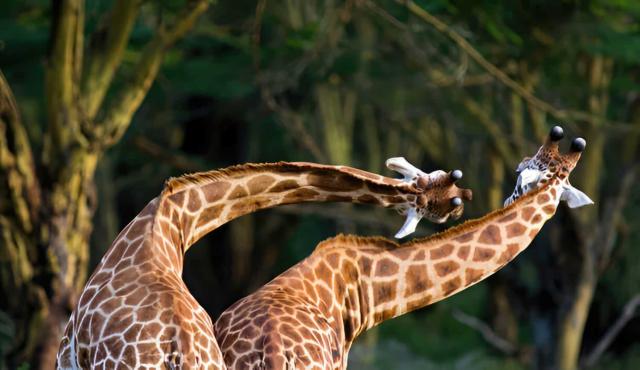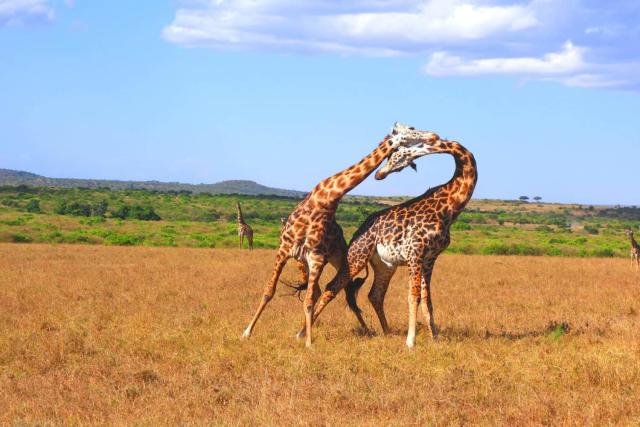Introduction: Giraffes and Their Unique Fighting Behavior
Giraffe Behavior: Why Do Giraffes Fight?
Giraffe Necking: The Power Behind the Fight
The Anatomy of a Giraffe Fight: How Do They Prepare?
The Results of Giraffe Fights: What Happens After a Battle?
How Do Giraffes Avoid Injury?
The Role of Giraffe Neck Strength in Their Social Structure
Giraffe Mating Behavior: Why Do Males Fight?
Giraffe Conservation: How Do Fights Affect the Species?
Conclusion: The Strange and Fascinating Giraffe Fight
When you think of giraffes, you probably picture their tall necks and elegant, slow-moving demeanor. But did you know that these gentle giants also engage in some pretty intense battles? Giraffe fights are both fascinating and unusual—especially when you consider how they use their necks in combat. Let’s take a closer look at the strange and surprising way giraffes fight, how they compete, and what the outcomes can be.

Giraffes don’t typically engage in physical fights like lions or Elephants-Are-Endangered.html">elephants, but they do have a unique combat behavior that’s all about establishing dominance. Fights usually happen between male giraffes (bulls) as they compete for the attention of females during mating season. These battles, known as "necking", are one of the most distinctive features of giraffe behavior. When two males fight, they swing their long, powerful necks at each other, using their heads like hammers to land blows on their opponent.
The necking ritual isn’t just about strength; it’s also a display of endurance and strategy. The giraffes take turns swinging their necks and trying to land hits on the other’s body or head. The battle ends when one giraffe backs down or is knocked off balance.
Now, let’s talk about those long necks! The giraffe’s neck is one of its most iconic features, and it’s also its most powerful weapon during fights. These necks can grow as long as six feet, and with muscles that are designed for both speed and power, giraffes can deliver devastating blows.
Interestingly, giraffes don’t use their necks just for combat—they also rely on them for everyday tasks like reaching high branches to feed and, in some cases, to communicate with each other. But when it comes to fighting, the neck is their tool of choice. The bulls will swing their heads like a pendulum, trying to strike their opponent in the chest, side, or head. Sometimes, giraffes use their heads to deliver forceful, direct blows—other times, they swing sideways to try and knock their rival off balance.
Before a fight even begins, giraffes will often engage in a bit of posturing. They might stand tall, spread their legs, and stare each other down, all while swinging their heads back and forth to show their strength. Once the battle kicks off, the two giraffes will lock necks and try to outlast each other.
The anatomy of the giraffe plays a huge role in these fights. Their muscular necks are incredibly strong, and their bodies are built to withstand impacts. The giraffe’s head is heavy, and the neck muscles are specially adapted to help them swing it with force. Their long legs and large body size also give them stability, which can be a big advantage in these battles.
When it comes to giraffe fights, the results can vary. Most of the time, the conflict ends with one of the males backing down—usually when one of them tires out or can’t land a decisive blow. The winner is often the one that can keep swinging its neck and maintain its balance while the other giraffe retreats.
But while the outcome may seem like a simple matter of endurance, there can be significant consequences for both participants. Although giraffe fights rarely end in death, they can cause serious injuries. The impact from a blow can break bones, bruise internal organs, or cause deep cuts that might lead to infection. In extreme cases, giraffes can suffer fatal injuries if a blow hits the wrong spot or if one of the males falls during the fight.
While giraffes are capable of delivering powerful blows, they are also careful during these battles. Giraffes generally fight in a way that minimizes the risk of injury—though, of course, accidents can still happen. Their fights often take the form of a series of controlled movements, with the giraffes carefully timing their neck swings and taking breaks when needed. This self-regulation helps reduce the chance of fatal injuries.
Additionally, the outcome of the fight is often determined by stamina rather than raw power. Giraffes that are more exhausted or less fit will typically lose the battle. However, even though injuries aren’t common, the energy expenditure involved in necking can lead to stress and even permanent damage if a giraffe loses multiple fights.
Giraffe necking isn’t just about winning a mate—it also plays a key role in giraffe social structure. Male giraffes engage in these battles to establish dominance within the herd. The stronger, more dominant bulls are more likely to secure mates and lead herds. It’s a way for giraffes to demonstrate their strength and assert their place within the social hierarchy.
This behavior also extends to giraffe herds themselves. While female giraffes usually do not engage in these types of fights, they do play a role in the social dynamics by watching the battles. The dominant bull typically gets the most attention from females, and a successful fight can lead to him attracting more mates. This process ensures that only the strongest genes are passed on to the next generation.

Male giraffes engage in necking battles primarily for one reason: mating. The dominant male, having proven his strength in battle, gains the right to mate with the female giraffes in the area. This ritual is part of giraffe courtship, where males compete for dominance and attention from females.
During mating season, giraffes spend a lot of time around each other, and the fights can become frequent as males vie for the best position in the herd. The “winner” of these necking battles will often get access to mates, while the “loser” may have to wait for another opportunity.
While giraffes are fascinating creatures, their populations are under threat in some areas due to habitat loss, poaching, and climate change. Interestingly, giraffe fights and their social behavior can play a role in conservation efforts. When males fight for dominance, it’s a way of maintaining genetic diversity within the population. However, if a large number of males are injured or killed during fights, it can negatively impact the overall population.
Conservation efforts are focused on preserving giraffe habitats, reducing human impact, and ensuring that giraffe populations remain strong. By protecting these gentle giants, we can ensure that their unique social and fighting behaviors continue to be part of the African landscape for generations to come.
Giraffe fights may seem strange at first glance, but they’re a critical part of giraffe behavior and social structure. These necking battles, while unusual, help establish dominance, secure mates, and maintain the genetic strength of giraffe populations. Though the outcomes of these battles can be dangerous, they are a natural and vital part of giraffe life. Whether you’re marveling at a giraffe’s towering neck or watching one of these battles unfold, it’s clear that giraffes are truly unique creatures—both in the wild and in the animal kingdom.
animal tags: Giraffe-fights
We created this article in conjunction with AI technology, then made sure it was fact-checked and edited by a Animals Top editor.